Expert's Rating
Pros
- Incredibly lightweight
- Ceraluminum is impressive
- Mind-blowing battery life
Cons
- A $600 laptop CPU in a $1,200 machine
- Seriously, this is the slowest Snapdragon X chip
- Ceraluminum feels almost plasticky and hollow
Our Verdict
The Asus ZenBook A14 is an incredible proof of concept for how light and long-lasting a laptop can be. But you shouldn’t buy it unless you’re willing to trade performance for an ultralight machine that gets more battery life than you probably need.
Price When Reviewed
This value will show the geolocated pricing text for product undefined
Best Pricing Today
The Asus ZenBook A14 is a fascinating machine. Its chassis is made of “Ceraluminum,” so it’s incredibly light and durable. Not only does it weigh just over two pounds, but it also offers amazing battery life. However, Asus has chosen to put the absolute slowest Qualcomm Snapdragon X chip in this machine.
The ZenBook A14, retailing for $1,200, uses a Snapdragon X chip that was originally intended for $600 laptops. Although this laptop offers extended battery life, I’m not sure the trade-off makes sense at this price point. For everyday tasks, a faster Snapdragon X chip would offer better performance (often at a lower price!). But if you’re happy with Windows on ARM and battery life is a top priority, then this might be the machine for you. It’s just a very small niche to target.
Asus ZenBook A14: Specs
The Asus ZenBook A14 features a Qualcomm Snapdragon X processor. We reviewed the UX3407QA model, which costs $1,200 at retail. This machine has a Qualcomm Snapdragon X X1-26-100 processor.
This is actually a newer, more entry-level Snapdragon X chip. It’s slower than the initial Snapdragon X Plus chips, which were the slowest of the lot. Here’s the official product matrix. As you can see, Snapdragon X comes in last with the slowest CPU (up to 3 GHz) and the slowest GPU (1.7 TFLOPS.) This does mean the machine uses less power and should get better battery life. But, again, Snapdragon X chips in general are already great at that. This doesn’t feel like $1,200-class performance.
While I’m told tariffs are affecting pricing, this is still much more than we’d expect to see a laptop with this chip sell for. Qualcomm promised laptops in the $600 range with this chip and Asus used it to deliver a longer-lasting $1,200 machine.
- Model number: UX3407QA
- CPU: Qualcomm Snapdragon X X1-26-100
- Memory: 32 GB LPDDR5X
- Graphics/GPU: Qualcomm Adreno
- NPU: Qualcomm Hexagon (45 TOPS)
- Display: 1920×1200 OLED display with 60Hz refresh rate
- Storage: 1 TB PCIe 4.0 SSD
- Webcam: 1080p webcam
- Connectivity: 2x USB Type-C (USB 4.0 Gen 3), 1x USB Type-A (USB 3.2 Gen 2), 1x HDMI 2.1 out, 1x combo audio jack
- Networking: Wi-Fi 6E, Bluetooth 5.3
- Biometrics: IR camera for facial recognition
- Battery capacity: 70 Watt-hours
- Dimensions: 12.23” x 8.42” x 0.53”
- Weight: 2.16 pounds
- MSRP: $1,200 as tested
The Asus ZenBook is technically impressive, as it’s super light and long-lasting.
Asus ZenBook A14: Design and build quality
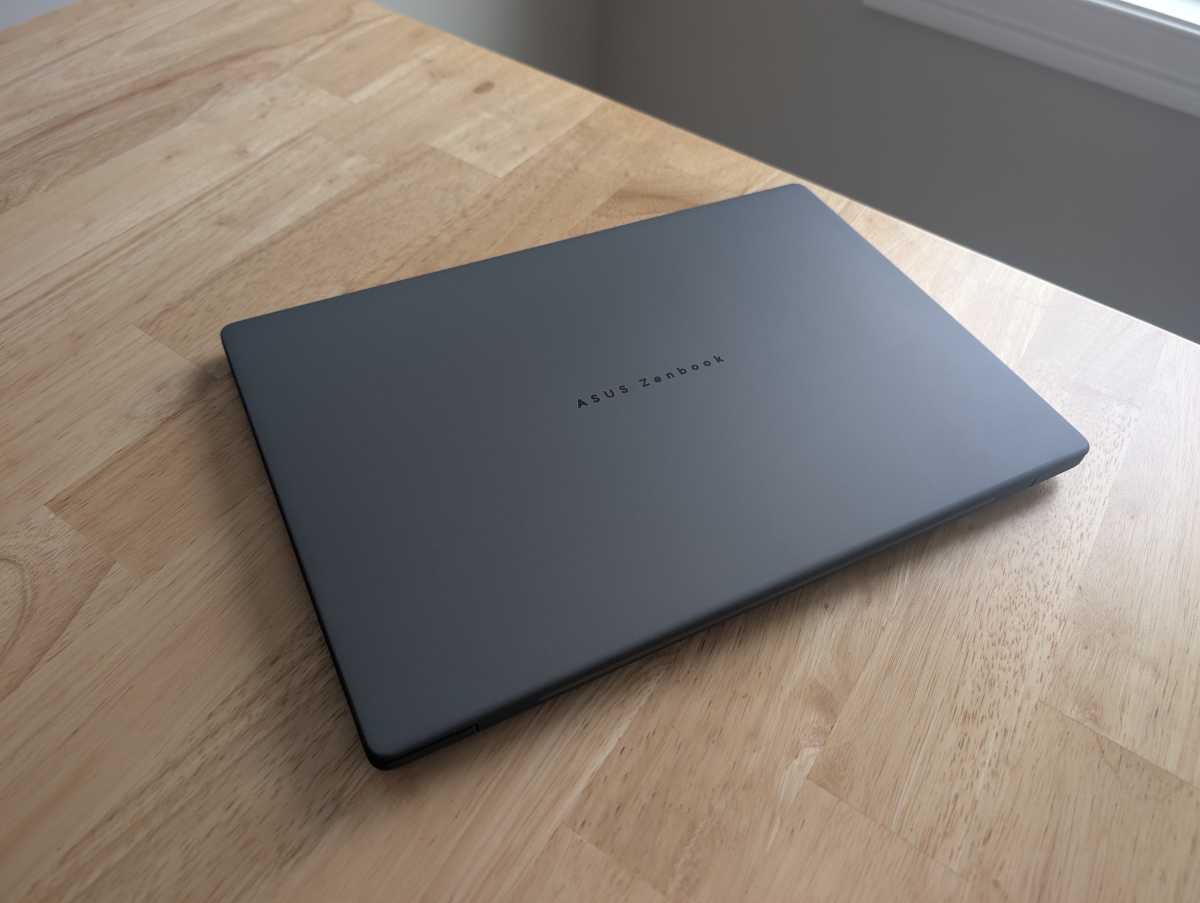
IDG / Chris Hoffman
The Asus ZenBook A14 is incredibly light. At just 2.16 pounds, picking it up almost feels like picking up a hollow machine.
That’s due to the “Ceraluminum,” the “revolutionary material” Asus is showing off here. It’s ceramic-coated aluminum, which Asus says “combines the lightness of aluminum with the resilience of ceramic.” It’s incredibly light! And, while Asus does say it’s rugged as well, I should note that I was not attempting to scratch or drop this machine to test that!
The Ceraluminum is interesting. It doesn’t feel like typical metal — you’re not touching metal, you’re touching ceramic. I wouldn’t say it feels cheap, but there’s something about picking it up that reminds me brain of picking up a plastic laptop and it’s so light that it’s almost like a hollow plastic laptop. We associate that “metal” feel with premium laptops and while there’s metal under the surface here, you won’t feel it. If you like a weighty metal laptop, this isn’t for you. But if you like the feel of something light, this is impressive. If you can get over the lack of metal feeling, you can feel like you’re picking up something almost impossibly light for the performance. That’s cool!
That’s the most impressive bit. The rest of the machine is standard — in a good way! This model is available in the “Iceland Gray” color with a black bezel and hinge. It’s easy to open the laptop with one hand. It feels nice and light to hold, maybe even too light if you prefer a weightier experience. It’s lighter than I expect a functional laptop to be.
Asus ZenBook A14: Keyboard and trackpad
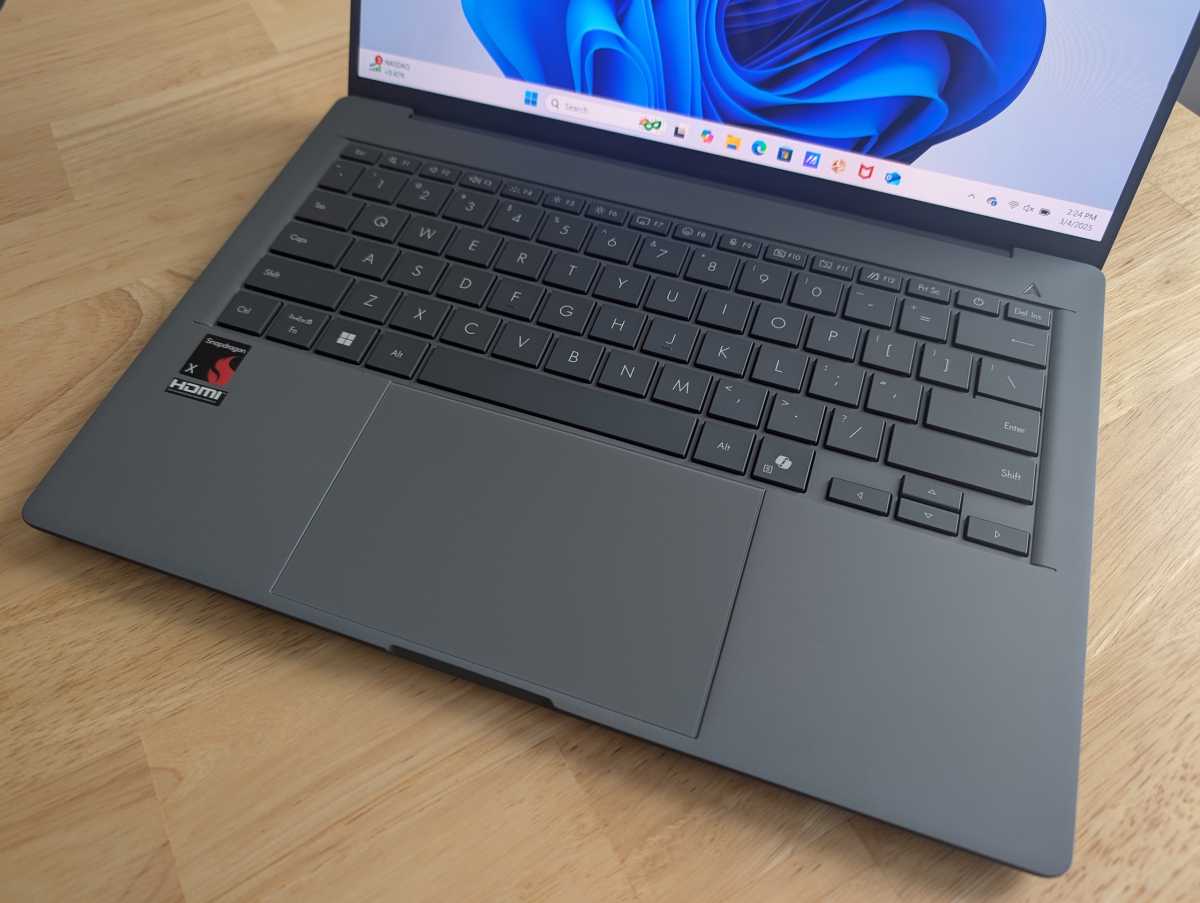
IDG / Chris Hoffman
The Asus ZenBook A14’s keyboard and trackpad are fine. Neither is unusually impressive, but both are certainly usable.
The keyboard features 1.3mm of key travel. It’s a tad squishy and doesn’t respond as crisply as the keyboards often do on a ThinkPad, for example. But it’s pretty good for a laptop focused on being light and thin.
The trackpad is a good size and in a good location right below the keyboard. The surface feels good to slide your finger over, and it has a pleasant “thunk” when you click down on it. As usual, I would prefer a haptic touchpad to make more of the trackpad’s surface clickable.
Asus ZenBook A14: Display and speakers
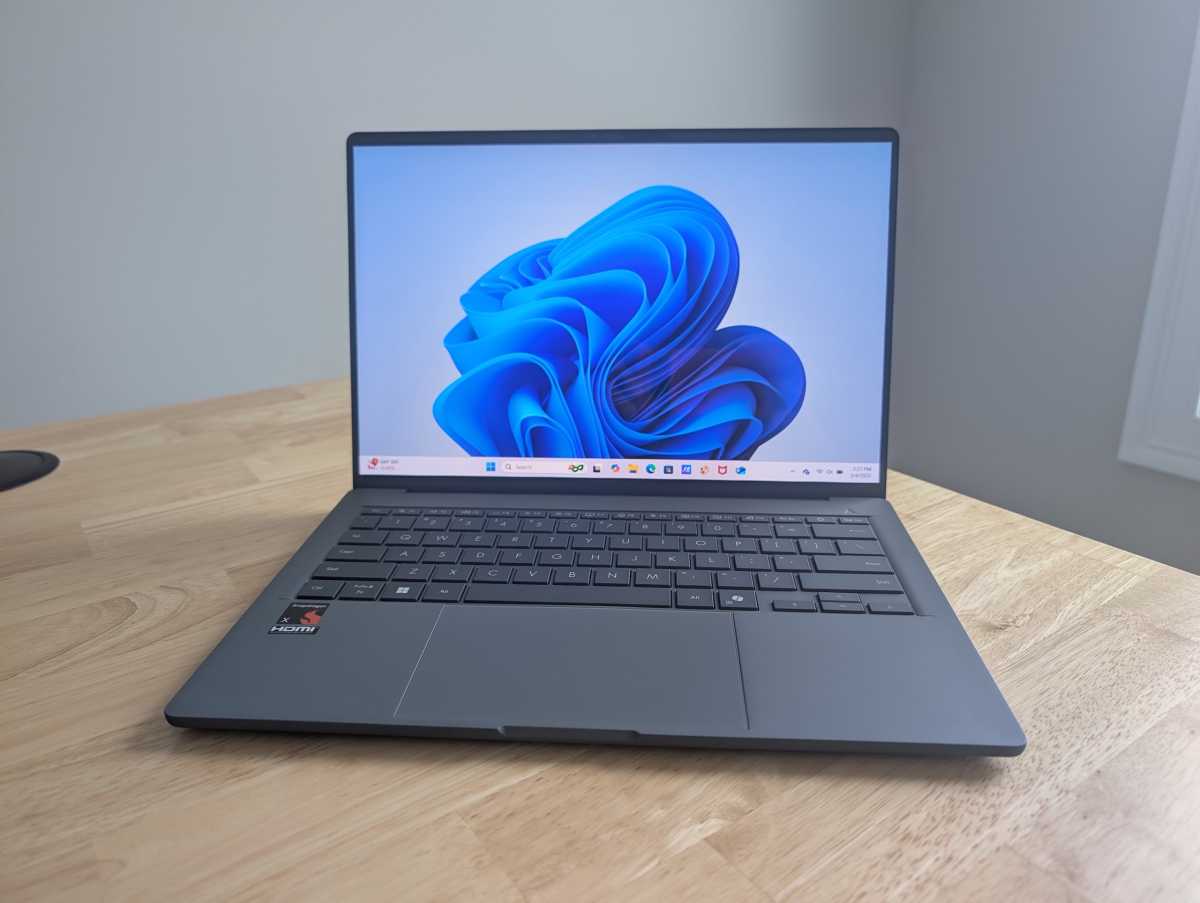
IDG / Chris Hoffman
The Asus ZenBook A14 has a decent display. Asus has chosen to include a 14-inch OLED display with a 1920×1200 resolution. It looks fine — I do like an OLED display!
On the other hand, this display only supports a 60Hz refresh rate. I understand that a higher refresh rate would lower battery life. On the other hand, this feels like not exactly the best spec for a $1,200 laptop. It’s not just about CPU performance. For a machine with a $600-laptop-class CPU, I’d hope components like the display would really sing to make up for that. It’s also worth noting that this is not a touchscreen display.
This machine’s speakers get plenty of volume, which is good. They’ll be great for video meetings and watching YouTube videos. On the other hand, the bass seems particularly underwhelming to me — really, that’s no surprise. Would a $1,200 ultralight laptop have an amazing subwoofer? Plan to bring headphones for music, movies, and TV shows.
Asus ZenBook A14: Webcam, microphone, biometrics
The Asus ZenBook A14 includes a 1080p webcam that actually produces a surprising crisp picture. It’s not perfect, but it’s better than average. It’ll be great for video meetings. There’s no physical camera shutter, though.
The microphone here sounds fine and you could certainly use it for meetings. I do feel like I’ve heard clearer, crisper audio from the microphones on other machines. But it’s fine. This machine isn’t the ultimate video meeting package, the goal is just having a decent mic.
Asus did include an IR camera for Windows Hello sign-in here and it works very well. You can easily sign into your PC just by opening this machine or sitting down in front of it. (There’s no fingerprint reader, however.)
Asus ZenBook A14: Connectivity
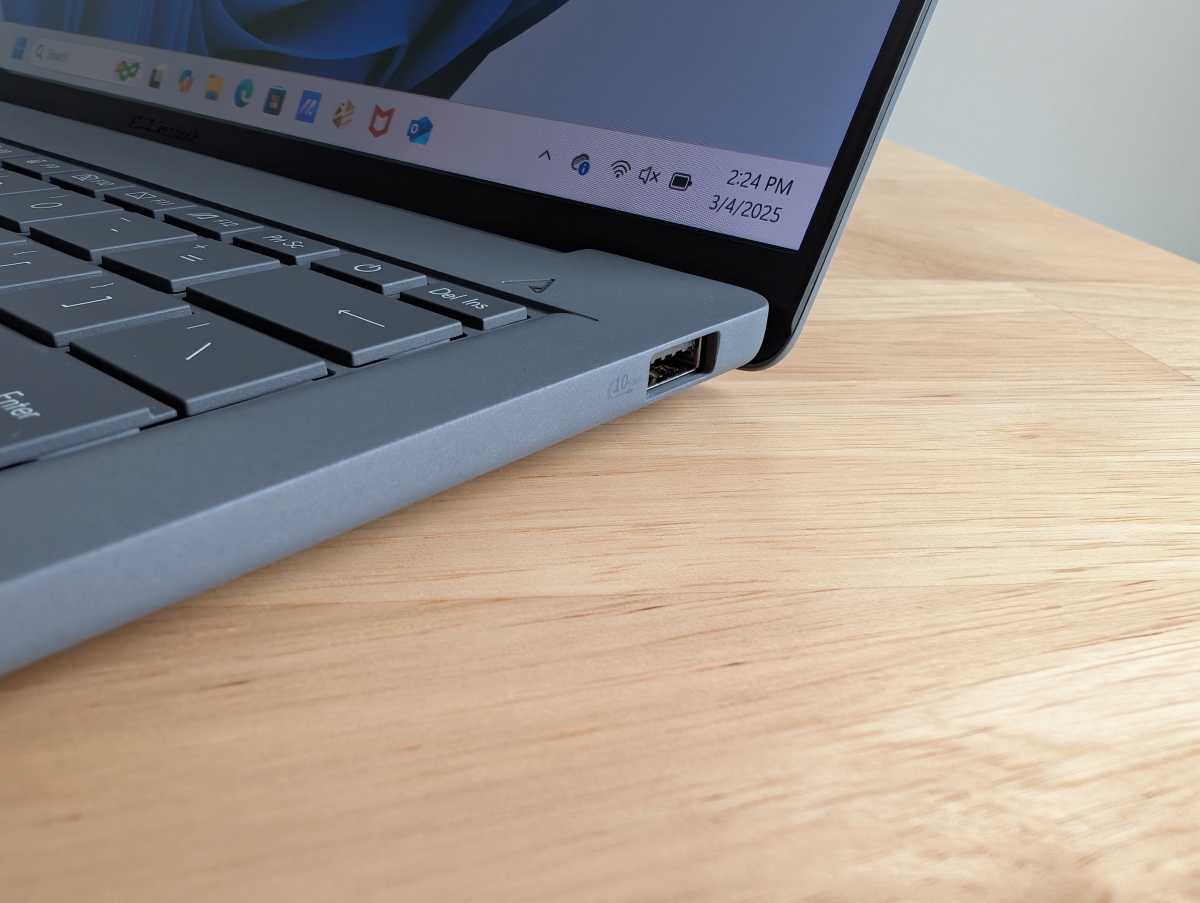
IDG / Chris Hoffman
The Asus ZenBook A14 features an okay selection of ports, but not a lot of them. That’s no surprise, as it’s an ultralight machine. I’m just happy to see a headphone jack here.
On the left side of the machine, you’ll find two USB Type-C ports, an HDMI out port, and a combo audio jack. Bear in mind that you will need one of the USB Type-C ports to charge the machine — it charges via USB-C. On the right side, you’ll find a single USB type-A port. That’s all. Plan to bring a dongle if you want more ports.
As far as radios, you have the usual Snapdragon X hardware here: Wi-Fi 6E and Bluetooth 5.3.
Asus ZenBook A14: Performance
The Asus ZenBook A14 performed fine in day-to-day desktop usage. Look, this is an ultralight laptop with a low-tier processor, I’m not doing serious heavy CPU usage tasks on it! For a web browser like Chrome and productivity tools like Microsoft Word, it worked fine. But for graphics-heavy tasks — gaming and professional apps that hit the GPU — it’s much slower than many other Snapdragon X Plus and Snapdragon X Elite-powered systems
(But buying a $1,200 laptop is a big commitment and you might eventually want to do something more demanding, more than just opening some extra browser tabs. That’s why the performance still matters.)
As always, we ran the Asus ZenBook A14 through our standard benchmarks to see how it performs. But, since this is an ARM-powered laptop, we can’t run all our normal benchmarks.
First, we run Cinebench R24, which has an ARM-native version. This is a heavily multithreaded benchmark that focuses on overall CPU performance. It’s a quick benchmark, so cooling under extended workloads isn’t a factor. But, since it’s heavily multithreaded, CPUs with more cores have a huge advantage.
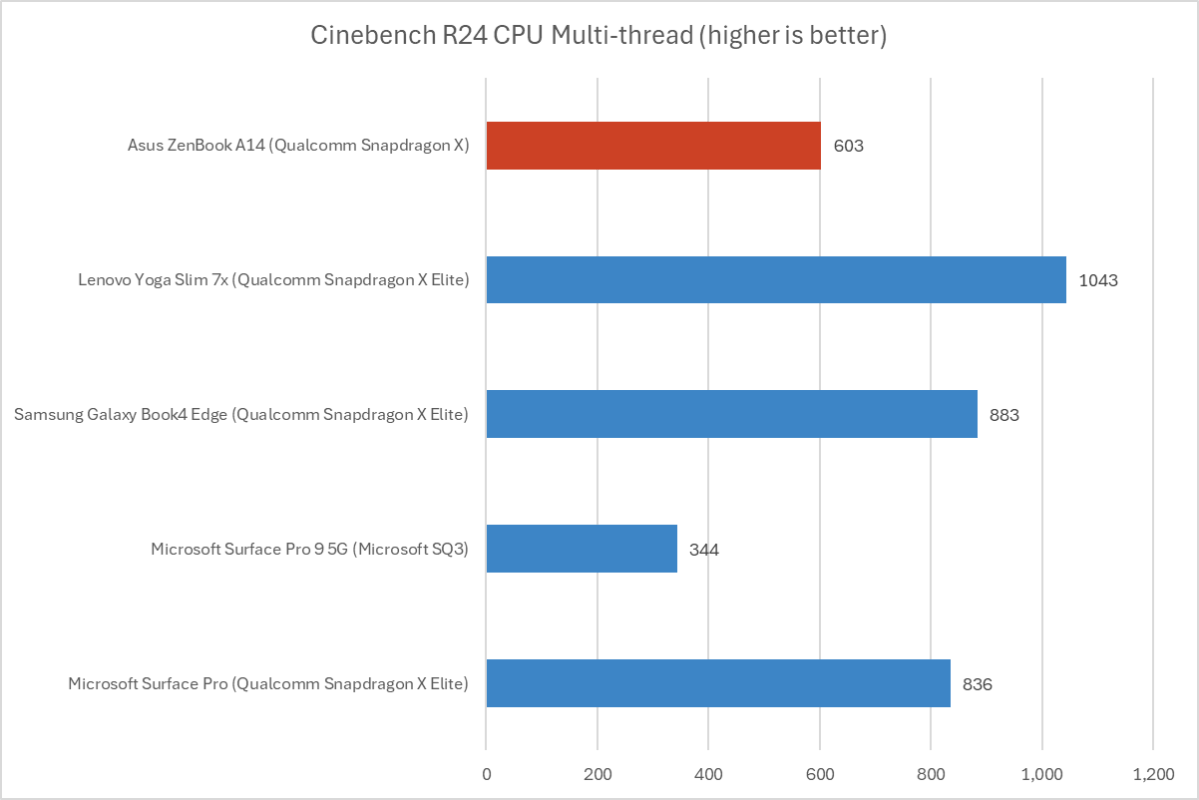
Login to add comment
Other posts in this group



TL;DR: Intuit QuickBooks Desktop Pro Plus 2024 is no

TL;DR: Today, April 27, is your last chance to get a


Are you the type of person who swears like a sailor or someone who pr

